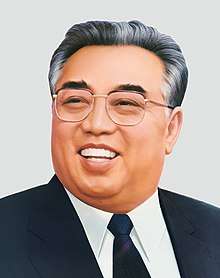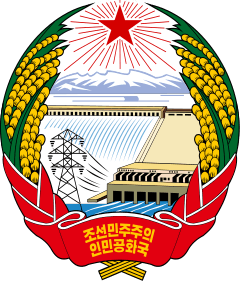Death and state funeral of Kim Il-sung
Kim Il-sung died on the afternoon of 8 July 1994 at age 82. North Korea's government did not report the death for more than 34 hours after it occurred. An official mourning period was declared from 8–17 July, during which the national flag was flown at half mast throughout the country, and all forms of amusement and dancing were prohibited.[1]
 Official portrait of Kim Il-sung | |
| Date | 8–17 July 1994 |
|---|---|
| Location | Pyongyang, North Korea |
| Participants | Kim Jong-il and North Korean military, government and Korean Workers' Party elites |
Part of a series on the |
||||||||||||||||||||||||||||||||||||||||||
|---|---|---|---|---|---|---|---|---|---|---|---|---|---|---|---|---|---|---|---|---|---|---|---|---|---|---|---|---|---|---|---|---|---|---|---|---|---|---|---|---|---|---|
| History of North Korea | ||||||||||||||||||||||||||||||||||||||||||
 | ||||||||||||||||||||||||||||||||||||||||||
|
||||||||||||||||||||||||||||||||||||||||||
|
| ||||||||||||||||||||||||||||||||||||||||||
Pyongyang radio said that Kim had succumbed to complications arising from a stroke as a result of psychological stress. In the years prior to his death, he had been receiving treatment for diabetes as well as the hardening of arteries in his heart.
Background
On the late morning of 8 July 1994, Kim Il-sung collapsed in Hyangsan from a sudden heart attack. After the heart attack, his son Kim Jong-il ordered the team of doctors who were constantly at his father's side to leave, and arranged for the country's best doctors to be flown in from Pyongyang. After several hours, the doctors from Pyongyang arrived, and despite their efforts to save him, Kim Il-sung died. His death was declared thirty hours later, respecting the traditional Confucian mourning period.[2]
Kim Il-sung's death resulted in nationwide mourning and a ten-day mourning period was declared by Kim Jong-il. His funeral in Pyongyang was attended by hundreds of thousands of people from all over North Korea. Kim Il-sung's body was placed in a public mausoleum at the Kumsusan Memorial Palace, where his preserved and embalmed body lies under a glass coffin for viewing purposes. His head rests on a Korean-style pillow and he is covered by the flag of the Workers' Party of Korea. Newsreel video of the funeral at Pyongyang was broadcast on several networks, and now can be found on various websites.[3] A further mourning period lasted until the third anniversary of his death in 1997.[4]
Reactions
Korean Peninsula


International reactions


Funeral service
Kim Jong-il was chairman of the funeral committee. The committee also included Defense Minister O Jin-u, and Vice President Kim Yong-ju, who was Kim Il-sung's younger brother.[10]
The funeral committee released communique regarding the funeral:
The State Funeral Committee publishes the following decision for the whole party, all the people and the entire army to express the deepest condolences over the death of the great leader Comrade Kim Il-sung and mourn him with the feelings of deep reverence:
- The coffin of the respected leader Comrade Kim Il-sung will be laid in state at the Kumsusan Assembly Hall.
- The period from 8th July to 17th July 1994, is set as the mourning period for the respected leader Comrade Kim Il-sung. The mourners will visit the bier from 11th July to 16th July 1994.
- The mourning service for the last parting with the respected leader Comrade Kim Il-sung will be held solemnly in Pyongyang, the capital of revolution, on 17th July 1994.
- At the time of the mourning service in Pyongyang, artillery salute will be fired in Pyongyang and provincial seats and the entire people across the country will observe a three-minute silence and all locomotives and ships sound whistles all at once in memory of the respected leader Comrade Kim Il-sung.
- During the mourning period, memorial services will be held at all the organs and enterprises throughout the country and memorial services be held in all provinces, cities and counties while the memorial service is held in Pyongyang.
- During the mourning period, organs and enterprises will hang the flag at half-mast, and all songs and dances, games and amusement will be banned.
- Foreign mourning delegations will not be received.
— Korean Central News Agency, 8 July 1994[11]
The State funeral was held on 17 July and included the observance of three minutes of silence throughout the country.[12] Attendance to the funeral was two million people.[13]
Funeral committee
The funeral committee was chaired by Kim Jong-il and had 273 members,[14] including:[15]
- Kim Jong-il
- O Jin-u
- Kang Song-san
- Ri Jong-ok
- Pak Song-chol
- Kim Yong-ju
- Kim Pyong-sik
- Kim Yong-nam
- Choe Kwang
- Kye Ung-thae
- Jon Pyong-ho
- Han Song-ryong
- So Yun-sok
- Kim Chang-man
- Choe Thae-bok
- Choe Yong-rim
- Hong Song-nam
- Kang Hui-won
- Yang Hyong-sop
- Hong Sok-hyong
- Yon Hyong-muk
- Ri Son-il
- Kim Chol-su
- Kim Ki-nam
- Kim Kuk-thae
- Hwang Jang-yop
- Kim Pok-sin
- Kim Chang-ju
- Kim Yun-hyok
- Jang Chol
- Kong Jin-tae
- Yun Ki-bok
- Pak Nam-gi
- Jon Mun-sop
- Yu Mi-yong
- Hyon Jun-kuk
- Won Tong-ku
- Ri Ha-il
- Kim Ik-hyon
- Ri Chang-son
- O Kuk-ryol
- Kwon Hui-kyong
- Kang Sok-sung
- Choe Hui-jong
- No Myong-kwon
- Jong Ha-chol
- Kim Tu-nam
- Paek Hak-rim
- Chi Chang-ik
- Ri Yong-u
- Ri Chi-chang
- Choe Pok-hyon
- Kim Chang-o
- Ri Sok-paek
- Pak Yong-sop
- Ri Chol-pong
- Jong Jun-ki
- Hwang Sun-hui
- Sin Sang-kyun
- Jong Ha-chol
- Kim Ki-ryong
- Kang Hyon-su
- Pak Sung-kil
- Kim Hak-chol
- Paek Pom-su
- Choe Mun-son
- Im Hyong-ku
- Ri Kun-mo
- Hyon Chol-kyu
- Ri Kil-song
- Im Su-man
- Ri Ul-sol
- Kim Pong-ryul
- Kim Kwang-sin
- Kim Jong-gak
- O Ryong-pang
- Kim Myong-kuk
- O Yun-hwi
- Kim Pyok-sik
- Jang Song-u
- Jon Jin-su
- Chu Sang-jong
- Kim Yong-chul
- Cho Myong-rok
- Kim Il-chol
- Paek Chang-sik
- Kim Yong-hun
- Kang Tong-yun
- Pak Chi-su
- Han In-chol
- Kim Ha-kyu
- Nam Sang-nak
- Hyon Chol-hae
- Ri Pong-won
- Kim Pyong-yul
- Chu Song-il
- Choe Yong-hae
- Choe Song-suk
- Kim Song-ae
- Paek In-jun
- Ri Mong-ho
- Mun Song-sul
- Yom Ki-sun
- Ri Yong-chol
- Jang Song-paek
- Kim Si-hak
See also
References
- North Korea Quarterly. Institute of Asian Affairs. 1 January 1994. p. 56.
- Demick, Barbara: Nothing to Envy: Ordinary Lives in North Korea.
- Scenes of lamentation after Kim Il-sung’s death
- "North Korea ends mourning for Kim Il Sung". CNN. 8 July 1997. Retrieved 9 May 2015.
- The Independent, 11 July 1994, Monday, "The Korean Succession: Fears of power struggle in North Korea"
- "South Korea assumes "for now" that Kim Il-sung died of natural causes", South Korean news agency, Seoul, in English, 11 July 1994, Monday
- "Pyongyang prevents foreigners from entering until after 17th July", KBS Radio, Seoul, 11 July 1994
- Eugene Bazhanov and Natasha Bazhanov, "The Evolution of Russian-Korea Relations", Asian Survey, vol. 34, no. 9 (1994).
- "North Korean President Kim Il Sung Dies at 82". The Washington Post. 9 July 1994.
- The Washington Times, 10 July 1994, Sunday, Final Edition, "The son takes charge in Pyongyang"
- "State funeral committee issues communique: foreign delegations not allowed". Korean Central News Agency, Pyongyang, in English. 9 July 1994.
- The Straits Times (Singapore) "Kim Il Sung dies of heart attack", 10 July 1994
- Gall, Timothy L; Gall, Susan B (1999). Worldmark Chronology of the Nations: Asia. 3. Farmington Hills: Gale Group. p. 316. ISBN 0-7876-0521-2.
- "Kim Il Sung". Cold War Reference Library. The Gale Group Inc. 2004. Retrieved 7 February 2019 – via Encyclopedia.com.
- 금수산 의사당서 10일장/김일성 장례 어떻게 치르나. Seoul Shinmun (in Korean). 10 July 1994. p. 5. Archived from the original on 18 January 2017.
Further reading
- "The Great Leader Comrade Kim Il Sung will Always Be with Us". History of Revolutionary Activities of President Kim Il Sung (PDF). Pyongyang: Foreign Languages Publishing House. 2012. ISBN 9789946008882.
- "January 1990—July 1994". Kim Il Sung: Condensed Biography (PDF). Pyongyang: Foreign Languages Publishing House. 2001. OCLC 500072623.
